Click on images to enlarge

infestation (Photo: Sheldon Navie)
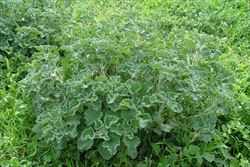
habit prior to flowering (Photo: Sheldon Navie)
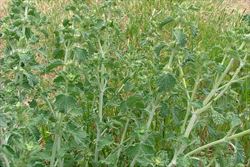
habit in flower (Photo: Sheldon Navie)
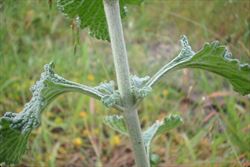
close-up of whitish hairy stems (Photo: Sheldon Navie)
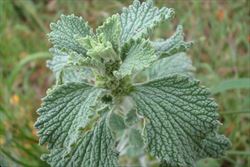
hairy leaves with a crinkled appearance (Photo: Sheldon Navie)

dense flower clusters in the leaf forks (Photo: Sheldon Navie)
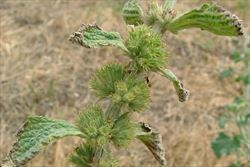
clusters of immature fruit (Photo: Sheldon Navie)
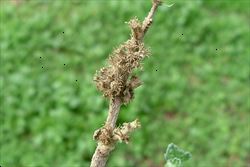
close-up of mature fruit with curved teeth (Photo: Sheldon Navie)
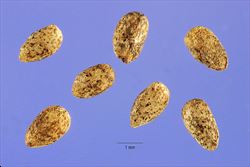
close-up of seeds (Photo: Steve Hurst at USDA PLANTS Database)

young plant (Photo: Sheldon Navie)
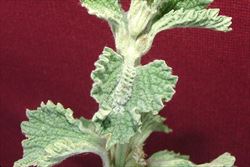
close-up of the larva of the horehound plume moth, Pterophorus spilodactylus (Photo: Sheldon Navie)

close-up of flowers, with two-lobed upper 'lips' and three-lobed lower 'lips' (Photo: Sheldon Navie)
Scientific Name
Marrubium vulgare L.
Synonyms
Marrubium album Gilib.
Prasium marrubium Krause
Family
Labiatae (South Australia)
Lamiaceae (Queensland, New South Wales, the ACT, Victoria, Tasmania, Western Australia and the Northern Territory)
Common Names
common horehound, hoarhound, horehound, hound's bane, houndsbane, marrube, marvel, white horehound, woolly horehound
Origin
This species is native to southern and western Europe, western and central Asia (i.e. Eurasia) and northern Africa.
Naturalised Distribution
A widely naturalised species that is found largely throughout the southern and eastern parts of the country. It is most common and widespread in New South Wales, the ACT, Victoria, Tasmania and the southern regions of South Australia. Also relatively common in the southern parts of Western Australia, scattered throughout southern and central Queensland, and naturalised on Norfolk Island.
Habitat
A weed of temperate, semi-arid and occasionally also sub-tropical regions. It is found along roadsides, railways, fence lines, waterways, and in waste areas, disturbed sites, gardens, pastures, grasslands, open woodlands and sometimes also in crops.
Habit
An upright (i.e. erect or ascending) or spreading (i.e. decumbent), long-lived (i.e. perennial), herbaceous plant. It usually grows 20-60 cm tall, but rarely reaches up to 1 m in height.
Distinguishing Features
- an upright or spreading long-lived herbaceous plant usually growing 20-60 cm tall.
- its stems are square in cross-section and both the stems and leaves are densely covered with whitish hairs.
- its oppositely arranged leaves are somewhat crinkled in appearance and have bluntly toothed margins.
- its small white tubular flowers (6-12 mm long) are borne in dense clusters in the upper leaf forks.
- these flowers are surrounded by a persistent green structure (i.e. calyx) that turns brown as the fruit matures.
- the fruiting 'calyx' (4-7 mm long) has ten backwards-curved teeth or spines.
Stems and Leaves
The stems are much branched, particularly towards the woody base of the plant, and roots (i.e. adventitious roots) can be produced from the lowest stem joints (i.e. nodes). These stems are square in cross-section (i.e. quadrangular) and densely covered with whitish coloured hairs (i.e. tomentose).
The oppositely arranged leaves are also covered in whitish hairs (i.e. tomentose), particularly on their undersides. Lower leaves have longer leaf stalks (i.e. petioles) than the upper leaves, with stalks usually from 10-25 mm long. These leaves (10-70 mm long and 8-45 mm wide) are egg-shaped in outline (i.e. ovate) or almost rounded (i.e. orbicular) and somewhat crinkled (i.e. rugose) in appearance. They also have bluntly toothed (i.e. crenate) margins and rounded tips (i.e. obtuse apices).
Flowers and Fruit
The white tubular flowers (6-12 mm long) are borne in dense clusters in the forks (i.e. axils) of the upper leaves. Flowers are two-lipped (i.e. bi-labiate), the upper 'lip' being divided into two lobes and the lower 'lip' being divided into three lobes. These flowers are surrounded by a persistent green tube (4-7 mm long) made up of the fused sepals. Flowering occurs throughout the year, but is most common during spring and summer.
The fruit contains four 'seeds' (i.e. mericarps or nutlets) enclosed in the old flower 'calyx', which has ten backwards-curved (i.e. recurved) teeth or spines. These 'seeds' (1-2.5 mm long) are brown or black in colour, egg-shaped (i.e. ovoid) or pear-shaped (i.e. pyriform), and have a slightly rough surface texture.
Reproduction and Dispersal
This species reproduces by seeds that are often spread inside the 'burr-like' fruit.
These fruit readily attach to animals, vehicles, and clothing and are also dispersed in water and contaminated agricultural produce.
Environmental Impact
Horehound (Marrubium vulgare) is regarded as an environmental weed in Victoria, South Australia, the ACT and Tasmania. While it is mainly a weed of agricultural areas, it also invades native vegetation. This species is actively managed by community groups in the ACT and was recently listed as a priority environmental weed in at least one Natural Resource Management region.
Legislation
This species is declared under legislation in the following states and territories:
- New South Wales: Class 4 - a locally controlled weed. The growth and spread of this species must be controlled according to the measures specified in a management plan published by the local control authority and the plant may not be sold, propagated or knowingly distributed (in a minority of local authority areas). See the New South Wales Department of Primary Industries Noxious Weeds List at http://www.dpi.nsw.gov.au for more detailed information on which local areas are covered in these declarations.
- South Australia: 3* - declared in Class 3e, a designation for agricultural weeds. This species is required to be controlled in part of the state only. See the Consolidated Proclaimed Plants List, produced by Primary Industries and Resources, South Australia, for more information about legislation for specific areas.
- Tasmania: D - the importation or sale of this species is prohibited and measures to reduce its population in an area, eradicate it from an area, or restrict it to a particular area may be required.
- Victoria: P1 - prohibited and must be eradicated or controlled (in the Port Phillip East region only), and C10 - all reasonable steps must be taken to control the weed and prevent its spread (in the Mallee, Wimmera, Glenelg, North Central, Corangamite, Port Phillip West, Goulburn, North East, West Gippsland and East Gippsland regions).
- Western Australia: P1 - the movement of this species or its seeds is prohibited (throughout some parts of the state), P2 - to be eradicated (throughout some parts of the state), P3 - a weed which cannot be eradicated in the short term, but must be kept under 'control' (in the Plantagenet local authority area only), and P4 - it must be 'contained' (in the Esperance, Jerramungup, Kent and Kojonup local authority areas).
Management
For information on the management of this species see the following resources:
- the Victorian Department of Primary Industries Landcare Note on this species, which are both available online at http://www.dpi.vic.gov.au.
- the Northern Territory Department of Natural Resources, Environment and The Arts Agnote on this species, which is available online at http://www.nt.gov.au/weeds.
- the Tasmanian Department of Primary Industries and Water Weed Service Sheet on this species, which is available online at http://www.dpiw.tas.gov.au.
Similar Species
Horehound (Marrubium vulgare) can be confused with stagger weed (Stachys arvensis), dead nettle (Lamium amplexicaule) and wild sage (Salvia verbenaca). These species can be distinguished by the following differences:
- horehound (Marrubium vulgare) has stalked leaves with bluntly toothed (i.e. crenate) margins, both at the base of the plant and along the flowering stems. Its stems and leaves are densely covered in whitish hairs (i.e. tomentose), its 'calyx' tubes have ten narrow teeth, and its flowers are white in colour.
- stagger weed (Stachys arvensis) has stalked leaves with bluntly toothed (i.e. crenate) margins, both at the base of the plant and along the flowering stems. Its stems and leaves have a few spreading hairs (i.e. sparsely pubescent), its 'calyx' tubes have five teeth, and its flowers are pale purple or pinkish in colour.
- dead nettle (Lamium amplexicaule) has stalked leaves with bluntly toothed (i.e. crenate) margins at the base of the plant, but the leaves along the flowering stems are stalkless (i.e. sessile) and have deeply toothed margins. Its stems and leaves are usually sparsely hairy (i.e. sparsely pubescent), its 'calyx' tubes have five teeth, and its flowers are pink, purple, bluish or reddish in colour.
- wild sage (Salvia verbenaca) has stalked leaves with toothed or slightly lobed margins at the base of the plant, and the leaves along the flowering stems are almost stalkless (i.e. sub-sessile) and have shallowly toothed (i.e. crenate) margins. Its stems and leaves are sparsely hairy (i.e. sparsely pubescent), its 'calyx' tubes have two 'lips' (the lower with two teeth), and its flowers are dark purple or bluish in colour.

